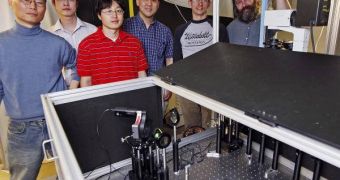Biomedical imaging techniques refer to tracking down particles injected into the human bodies to their destination, and assessing their behavioral patterns. This can be done using fluorescent markers, which are then observed with specialized equipment, designed specifically to track a certain type of marker. Now, experts at the Purdue University have developed a new way to do this, by creating nanostars that spin when subjected to a rotating magnetic field. When they do this, they scatter the light shone on them, creating a pulsating effect, a twinkle.
This type of signals can be very easily detected from the myriad of others that exist in the average human cell, where the level of activity is unbelievable. Being able to identify the exact marker you're looking for has proven to be relatively difficult with previous methods, and that's why the new structures hold so much promise for the field. Details of the National Institutes of Health-funded work can be found in the latest issue of the Journal of the American Chemical Society.
“This is a very different approach to enhancing contrast in optical imaging. Brighter isn't necessarily better for imaging; the real issue is background noise, and you can't always overcome this simply by creating brighter particles. With gyromagnetic imaging we can zero in on the nanostars by increasing signal strength while cutting down on background noise,” Purdue University Center for Cancer Research member Alexander Wei explains. He is also a professor of chemistry at the university, and a member in the Oncological Sciences Center.
The way the stars get their spin is through the use of iron oxide in their cores. The metal easily responds to magnetic forces. Measuring about 100 nanometers from one end to the other, the nanostars' arms are designed specifically to reflect light in a certain way when properly aligned. This allows the researchers to boost its intensity when this is required in order to surpass background noises, ScienceDaily reports.
“It was surprising how well this method enhanced the imaging. It can improve the contrast of the particles to the background noise by more than 20 decibels and can clearly reveal a gyrating nanostar, where with existing direct imaging methods in many cases you wouldn't be able to definitively find a particle,” PU Associate Professor of Physics Kenneth Ritchie, the co-leader of the research team, says.

 14 DAY TRIAL //
14 DAY TRIAL //